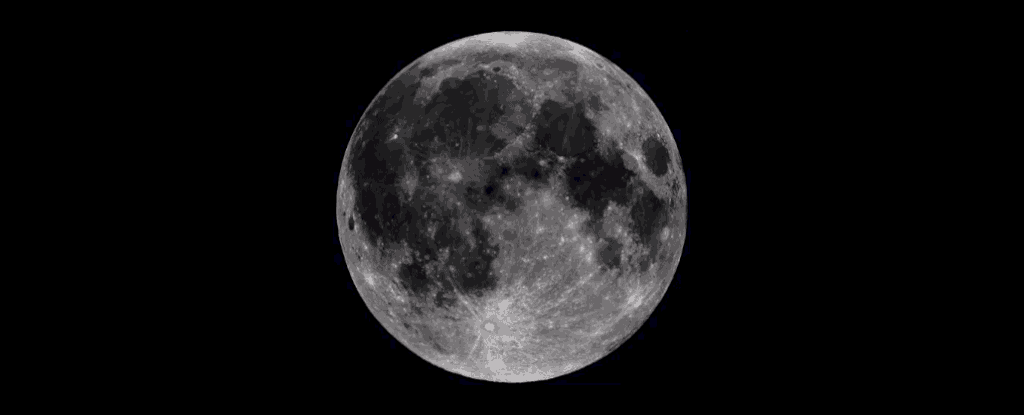
You may not realise it, because we always see the same side of it from Earth, but the Moon is pretty weird. The side we see is very different from the far side, which is always facing away from us, and the contrast between these two sides has been a baffling oddity.
Now we have a new possible explanation: Sometime in its distant past, the Moon could have experienced a giant collision with another object, which in turn could explain the strange difference between the two hemispheres.
So what is going on with old Moony McMoonface up there? Well, a few things. The two sides look different: If you look at the full Moon on a clear night, you'll see big, dark splotches. These are the lunar maria, flat wide plains or 'oceans' of volcanic basalt.
In stark contrast, when Soviet probe Luna 3 took the first pictures from lunar orbit in 1959, we found that the far side is pale and heavily pockmarked all over with thousands of craters. And it's not because the Earth protects the nearside from meteorites - we're too far away to make much of a difference there.
The differences go deeper than just looks. More recent data from 2012 revealed that the far side also has a crust that's thicker by 20 kilometres (12 miles), covered by an extra 10-kilometre-thick layer of material rich in magnesium and iron not found on the near side.
See? Weird. And we just don't know why.
Previous hypotheses have included a second moon that merged with our Moon in the early days of the Solar System, resulting in a sort of Moon hybrid.
But another possibility is a large asteroid or planemo that somehow wound up in solar orbit, putting it on a collision course with the Moon. This latter scenario, using 2012 data, is the hypothesis that lunar scientists led by astrophysicist Meng Hua Zhu of Macau University of Science and Technology have now put to the test.
The researchers ran computer simulations of 360 impact scenarios, slamming giant objects into an impact region on the near side to see if any could produce the Moon's asymmetry as we see it today. And they found one.
The best fit would have been an object around 780 kilometres (480 miles) in diameter - that's around a third of the size of Pluto, just over a quarter of the Moon's size, and just a little bit smaller than dwarf planet Ceres.
This object would've had to hurtle at around 22,500 kilometres per hour (14,000 miles per hour) when it smacked into the Moon.
A smaller object could have done it, too - around 720 kilometres across, travelling a little bit faster, at 24,500 kilometres per hour.
The effect would be more or less the same for both of these impacts. They'd spew up a whole bunch of rock and dust, at a depth of up to 300 kilometres, which would rain back down on the far side, covering it in a layer 5 to 10 kilometres deep, consistent with the magnesium-iron layer observed in 2012.
The impact would have displaced the crust, too, resulting in crust flowing away from the impact site. This model reproduced the Moon's crustal thickness distribution seen today.
And, because the Moon was relatively young when this happened, with high internal temperatures, it could easily have relaxed back into a rounded shape, effectively erasing the huge impact basin.
The model could explain something else, too. Earth and the Moon are largely made up of the same basic stuff, but the Moon has unexplained abundances of some isotopes on its surface - potassium, phosphorus and rare-earth elements such as tungsten-182.
In the model, these could have been excavated by the impact and rained back down to end up on the lunar surface.
It's a neat explanation, but some scientists may not be entirely convinced.
"This is a paper that will be very provocative," said planetary scientist Steve Hauck of Case Western Reserve University and Editor-in-Chief of the journal that published the study.
"Understanding the origin of the differences between the nearside and the farside of the Moon is a fundamental issue in lunar science.
"Indeed, several planets have hemispherical dichotomies, yet for the Moon we have a lot of data to be able to test models and hypotheses with, so the implications of the work could likely be broader than just the Moon."
The research has been published in the Journal of Geophysical Research: Planets.
https://www.sciencealert.com/a-colossal-smash-up-with-a-dwarf-planet-could-have-made-the-moon-a-weirdo
2019-05-21 06:43:19Z
CBMiZmh0dHBzOi8vd3d3LnNjaWVuY2VhbGVydC5jb20vYS1jb2xvc3NhbC1zbWFzaC11cC13aXRoLWEtZHdhcmYtcGxhbmV0LWNvdWxkLWhhdmUtbWFkZS10aGUtbW9vbi1hLXdlaXJkb9IBamh0dHBzOi8vd3d3LnNjaWVuY2VhbGVydC5jb20vYS1jb2xvc3NhbC1zbWFzaC11cC13aXRoLWEtZHdhcmYtcGxhbmV0LWNvdWxkLWhhdmUtbWFkZS10aGUtbW9vbi1hLXdlaXJkby9hbXA
Bagikan Berita Ini















0 Response to "A Colossal Smash-Up With a Dwarf Planet May Have Messed Up Our Moon - ScienceAlert"
Post a Comment